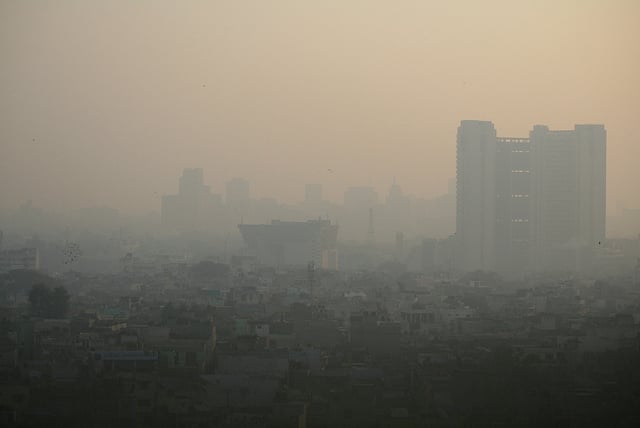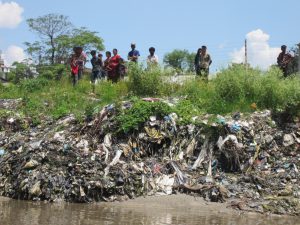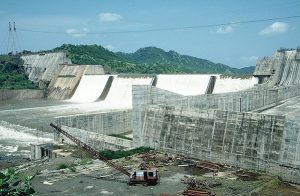Environment Minister Prakash Javadekar launched India’s first national air quality index this week to monitor pollution levels in a country which has the world’s most toxic air.
The air quality index from the Central Pollution Control Board explains in layman’s terms the effect that breathing the air in 10 cities could have on a person’s health.
The central and state pollution control boards already monitor air quality in 240 cities across the country, but the data generated is voluminous and difficult for ordinary people to understand.
“It was important that information on air quality is put up in public domain in simple linguistic terms that is easily understood by a common person,” said Javadekar.
The index translates detailed information on eight different pollutants into a colour-coded warning system (including PM2.5 the smallest most dangerous particulate matter). Previously systems only recorded three pollutants.
The index, overseen by the environment ministry, calculates the average pollution for a day, which the government says is a better way to judge air quality.
Technical glitches
Environmentalists have welcomed the new air quality index, however there are concerns about the accuracy of data.
It is vital to ensure monitoring stations produce good quality data and are properly maintained, warned Anumita Roychowdhury, executive director of transport and air quality at the Delhi-based non-profit Centre for Science and Environment (CSE).
So far, India’s collection of pollution data has been haphazard and compares poorly with China.
Days after launching, the system ran into technical problems. As of April 10, the AQI website readings from three of the five stations in Delhi showed “Insufficient Data for computing AQI”. And in some cases, data was missing for periods of time. Stations also only showed recordings for five out of the eight pollutants.
Functioning stations in Delhi this week showed an average air quality of “moderate” which means “breathing discomfort” to people with asthma as well as those with diseases of the heart and lungs. But in some places the levels of PM2.5 hit 12 times the World Health Organisation’s safe limit.
Read also: Breathing gets more injurious to health in India’s capital
Elsewhere in India, stations in Chennai showed alarming levels of PM2.5 and the holy city of Varanasi on the banks of the Ganga River recorded an AQI as high as 252 or “poor” , which means “breathing discomfort to most people on prolonged exposure” and is far higher even than pollution levels in Delhi.
Action on smog needed
The Centre for Science and Environment (CSE) has called on the government to take immediate action to reduce smog.
India has joined the global league of countries like the US, China, Mexico, France and Hong Kong that have implemented smog alert systems. However, other countries also implement emergency measures to bring down the peak pollution levels, CSE has pointed out.
Air quality warning systems in Beijing have helped build public awareness about the health impacts and put pressure on the government to take action (though there are still big concerns about data rigging).
Beijing has also come up with a pollution contingency plan. On red alert days, schools are closed, car-use is restricted, polluting factories have to cut emissions and barbecues and fireworks are banned. US and European cities have similar systems.
Greenpeace India has also voiced concerns about the lack of action to curb existing pollution levels in Delhi and to safeguard the health of the public. A recent Greenpeace survey revealed school children are consistently exposed to unacceptable levels of pollution.
“Delhi is facing a public health emergency and an Air Quality Index needs to be matched with actionable plans on how to bring the pollution levels down, at the very least with a health advisory,” said Aishwarya Madineni a Greenpeace campaigner.
“This [AQI] is merely band aid on a wound that needs stitches, the bleeding is going to continue,” she said.
Fresh ban on old diesel cars
Delhi has taken recently taken measures to control pollution from vehicles, a major culprit behind the city’s toxic air. Within days of a National Green Tribunal (NGT) ruling banning diesel-run vehicles over 10 years old in Delhi and the neighbouring states of Haryana and Uttar Pradesh, the Delhi police had rounded up 100 vehicles.
Chairperson of the green tribunal, Justice Swatanter Kumar, noted that diesel is prime source of air pollution in Delhi and the situation has become so alarming that people are being advised to leave Delhi due to adverse effects on health.
Last November, the Tribunal passed a ruling to ban all vehicles over 15 years old. However, the ban was not implemented by the states.
Delhi authorities need to enforce tighter emissions standards for vehicles and fuel taxes, argued Vivek Chhattopadhyay from the Centre for Science and Environment (CSE). About 45% of cars in Delhi are diesel run and pollution from one diesel car is equal to about seven petrol cars, he said.
The new order is expected to cover around 1.19 million private diesel cars and about 35,000 commercial vehicles (these were registered before Delhi made clean natural gas compulsory for commercial vehicles). The ban will also restrict the entry of about 10,000 cars registered in Noida and Ghaziabad into Delhi.
Vishnu Mathur, director general of Society of Indian Automobile Manufacturers (SIAM), argued the ban should been implemented nationwide since old vehicles will simply be resold and continue to pollute elsewhere.
Other countries have taken strong steps to phase out old vehicles. In 2014, about 7 million vehicles were banned from the road in China because they failed to meet emissions standards, though cities are still struggling to curb car fumes.





